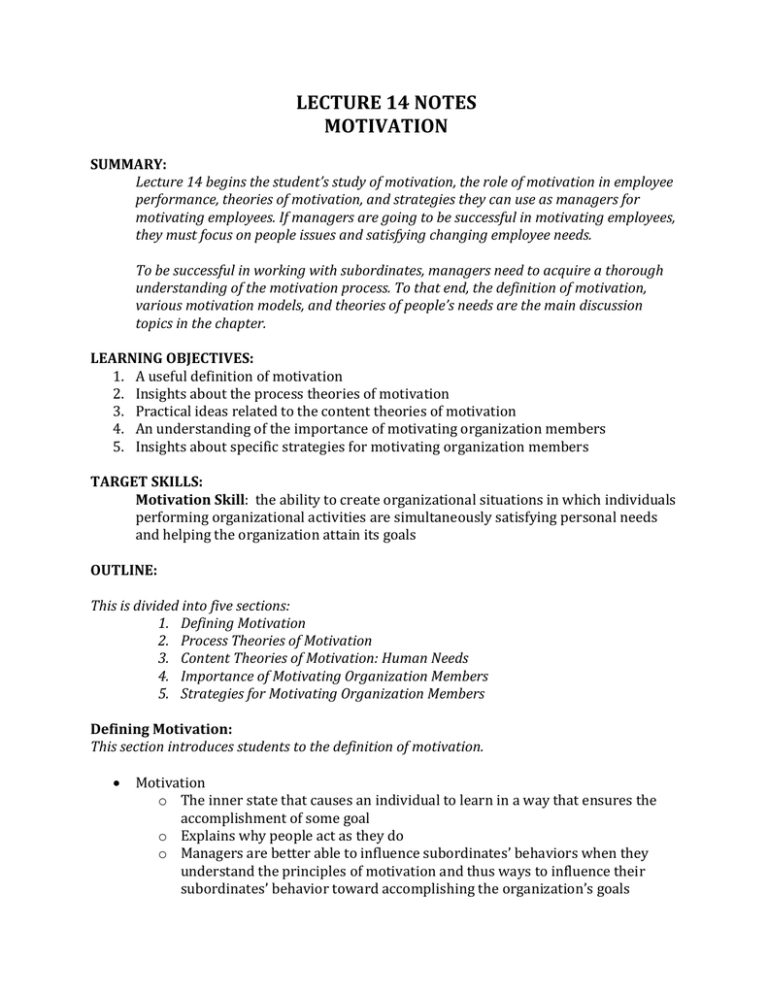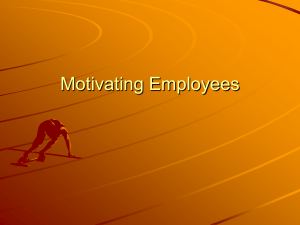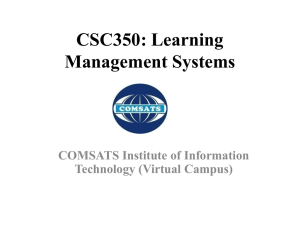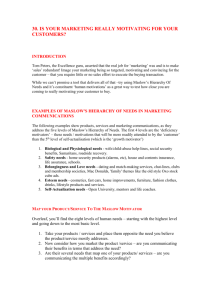Lecture14
advertisement

LECTURE 14 NOTES MOTIVATION SUMMARY: Lecture 14 begins the student’s study of motivation, the role of motivation in employee performance, theories of motivation, and strategies they can use as managers for motivating employees. If managers are going to be successful in motivating employees, they must focus on people issues and satisfying changing employee needs. To be successful in working with subordinates, managers need to acquire a thorough understanding of the motivation process. To that end, the definition of motivation, various motivation models, and theories of people’s needs are the main discussion topics in the chapter. LEARNING OBJECTIVES: 1. A useful definition of motivation 2. Insights about the process theories of motivation 3. Practical ideas related to the content theories of motivation 4. An understanding of the importance of motivating organization members 5. Insights about specific strategies for motivating organization members TARGET SKILLS: Motivation Skill: the ability to create organizational situations in which individuals performing organizational activities are simultaneously satisfying personal needs and helping the organization attain its goals OUTLINE: This is divided into five sections: 1. Defining Motivation 2. Process Theories of Motivation 3. Content Theories of Motivation: Human Needs 4. Importance of Motivating Organization Members 5. Strategies for Motivating Organization Members Defining Motivation: This section introduces students to the definition of motivation. Motivation o The inner state that causes an individual to learn in a way that ensures the accomplishment of some goal o Explains why people act as they do o Managers are better able to influence subordinates’ behaviors when they understand the principles of motivation and thus ways to influence their subordinates’ behavior toward accomplishing the organization’s goals Motivation Theories are categorized into two types: o Process Theory of Motivation Emphasize how individuals are motivated and focus on the steps that occur when an individual is motivated o Content Theory of Motivation Emphasize people’s internal characteristics and focus on understanding what needs people have and how those needs can be satisfied Process Theories of Motivation: This section introduces students to the process theories of motivation. The theories in this section build on one another to furnish a description of the motivation process that begins at a relatively simple and easily understood level and culminates at a somewhat more intricate and realistic level. Needs-Goal Theory Vroom Expectancy Theory Equity Theory Porter-Lawler Theory o The Needs-Goal Theory of Motivation Figure 14.1 illustrates the Needs-Goal Theory of Motivation Most fundamental of the motivation theories Motivation begins with an individual feeling a need The need transforms into a behavior that supports the performance of goal behavior to significantly reduce the felt need Goal setting can play a prominent role in influencing motivation Research provides evidence that individuals who set goals have an easier time focusing on activities relevant to those goals and avoid distractions that prevent them from reaching their goals The Role of Individual Needs Managers must understand the personal needs of employees if they are going to have success in motivating employees Offering rewards not valued by employees does not motivate employees Managers must be familiar with the needs their employees have and offer them rewards that can satisfy those needs o The Vroom Expectancy Theory of Motivation Motivation is much more complex than the needs-goal theory identifies – the Vroom Expectancy theory addresses the complexities Based on the premise that felt needs cause human behavior Also addresses the idea of Motivation Strength Individual’s desire to perform a behavior Motivation strength fluctuates as an individual’s desire increases or decreases Motivation and Perceptions Figure 14.2 illustrates the Expectancy Theory in equation form Motivation strength is determined by the perceived value of the result of performing a behavior and the perceived probability the behavior performed will cause the result to materialize As these factors increase, motivation strength and the desire to perform the behavior also increase o Equity Theory of Motivation Stacy Adams When individuals believe they have been treated unfairly in comparison to other coworkers, they react in a way to try to fight the inequity Change work outputs to better match the rewards they are receiving Change the compensation they receive by asking for a raise or taking legal action Change their perceptions of the inequality Leave the situation rather than try to change it Perceptions of inequality come from a variety of situations, including work assignments, promotions, compensation, ratings reports, and office assignments All of the situations are emotionally charged because they all relate to an individual’s perception of their self-worth o The Porter-Lawler Theory of Motivation Figure 14.3 illustrates the Porter-Lawler theory of motivation Accepts the premise that needs drive behavior and the effort an individual puts forth in their behavior is determined by the individual’s perception of the value of the rewards that result from finishing the task and the probability they will receive those rewards Additional characteristics of the theory include: Perceived value of the reward is determined by both intrinsic and extrinsic rewards that result when a task is accomplished o Intrinsic reward comes directly from performing the task o Extrinsic reward is extraneous to the task Extent to which an individual effectively accomplishes a task is determined primarily by two variables: the individual’s perception of what is required to perform the task and the individual’s ability to perform the task Perceived fairness of rewards influences the amount of satisfaction produced by those rewards Content Theories of Motivation: Human Needs: This section provides a discussion of content theory needs focusing on needs for self-respect, respect from others, promotion, and psychological growth. The content theory needs have been developed to help managers understand these needs. Maslow’s hierarchy of needs Alderfer’s ERG theory Argyris’s maturity-immaturity continuum McClelland’s acquired needs theory Maslow’s Hierarchy of Needs o Figure 14.4 illustrates the Maslow Hierarchy of Needs o Maslow stated that human beings possess five basic needs and those needs can be arranged in a hierarchy of importance – the order in which individuals generally strive to satisfy the needs Physiological Need Food, water, shelter, rest, sex, air Security or Safety Need Free from harm, including both bodily and economic disaster Social Need Desire for love, companionship, and friendship Esteem Need Desire for respect Self-Actualization Need Desire to maximize whatever potential an individual possesses o Greatest concern is the hierarchy has no research base, may not accurately reflect basic human needs, and is questionable whether human needs are really neatly arranged into a hierarchy o However, the hierarchy is the most popular conceptualization of human needs to date and continues to be widely discussed in management literature Alderfer’s ERG Theory o Clayton Alderfer o Was critical of Maslow’s theory so conducted his own research and identified three basic categories of needs – (ERG Needs) Existence Need – need for physical well-being Relatedness Need – need for satisfying interpersonal relationships Growth Need – need for continuing personal growth and development o Comparing Maslow to the ERG Theory: Alderfer has three needs; Maslow five Alderfer found that individuals are able to activate their higher-level needs prior to the satisfaction of the lower-level needs Alderfer identified that movement along the hierarchy is not always upward Argyris’s Maturity-Immaturity Continuum o Chris Argyris o Provides insights into human needs with a continuum concept focusing on personal and natural development of people to explain human needs o People naturally progress from immaturity to maturity as they move: From a state of passivity as an infant to a state of increasing activity as an adult From a state of dependence on others as an infant to a state of relative independence as an adult From being capable of behaving in only a few ways as an infant to being capable of behaving in many different ways as an adult From having erratic, casual, shallow, and quickly dropped interests as an infant to having deeper, more lasting interests as an adult From having a short-time perspective as an infant to having a much longer-time perspective as an adult From being in a subordinate position as an infant to aspiring to occupy an equal or subordinate position as an adult From a lack of self-awareness as an infant to awareness and control over self as an adult o Needs are not arranged in a hierarchy o Similarly to Maslow, the theory is primarily a subjective explanation of human needs McClelland’s Acquired Needs Theory o David C. McClelland – 1960s o Focuses on the needs people acquire through their life experiences o Emphasizes three of the many needs human beings develop in their lifetimes: Need for Achievement – nAch The desire to do something better or more efficiently than it has ever been done before Need for Power – nPower The desire to control, influence, or be responsible for others Need for Affiliation – nAff The desire to maintain close, friendly, personal relationships o An individual’s life experiences determine which of these needs will be highly developed and therefore dominate their personality o McClelland’s study of these three needs do have significant implications for management Need for Achievement Can be so strong in some individuals that it becomes more motivating than the quest for profits These individuals set goals for themselves that are challenging yet achievable People with a small need for achievement tend to stay away from challenging goals, responsibilities, and risk Need for Power Greatly motivated to influence others and assume responsibility for subordinates’ behavior Seek advancement with activities involving increasing amounts of responsibility Comfortable in competitive situations and enjoy decision making Need for Affiliation Cooperative, team-centered managerial style Prefer to influence subordinates to complete tasks through team efforts Can lose effectiveness if their need for social approval and friendship interferes with willingness to make decisions Importance of Motivating Organization Members: This section focuses on providing students a discussion of why motivation is so important for managers to study and understand. Motivation drives an individual’s behavior which drives goal accomplishment and productivity. People are motivated to perform behavior that satisfies their personal needs Therefore, managers need to understand providing opportunities that satisfy needs results in productive behavior within the organization Figure 14.5 makes the point unsatisfied needs can lead organization members to perform either appropriate or inappropriate behavior Strategies for Motivating Organization Members: This section discusses a variety of strategies available to managers for motivating their organization members. Each strategy is aimed at satisfying needs through appropriate organizational behavior. Managerial Communication o The most basic motivation strategy managers can use is to communicate well with organization members o Communication is a basic tool for satisfying the human needs of organization members o The Tips for Managing Around the Globe box in the text provides a discussion of communicating rewards that align with values Theory X-Theory Y o Douglas McGregor identified two sets of assumptions o Theory X Involves negative assumptions about people that McGregor believes managers use as their basis for dealing with subordinates Dislike of work, naturally lazy, avoid work when they can McGregor assumes these managers are “Bad” o Theory Y Represents positive assumptions about people that McGregor believes managers use as their basis for dealing with subordinates Self-direction, creative, seek responsibility, exercise self-control McGregor assumes these managers are “Good” Job Design o The process of designing the jobs organization members perform o Earlier Job Design Strategies Make jobs simpler and more specialized to increase worker productivity o Job Rotation Move workers from job to job rather than requiring them to perform only one simple and specialized job over the long term o Job Enlargement Increase the number of operations an individual performs in order to enhance their satisfaction with work o Job Enrichment Frederick Herzberg research on the degrees of satisfaction and dissatisfaction organizational members feel are two different variables determined by two different sets of items Hygiene, Maintenance Factors o Relate to the work environment o When these factors are undesirable, the individual becomes dissatisfied Motivating Factors o Relate to the work itself o When these factors are compelling, the individual is usually motivated to perform a better job The process of incorporating motivators into a job situation is job enrichment Table 14.1 lists the items that make up Herzberg’s hygiene and motivating factors Job Enrichment and Productivity Herzberg’s overall conclusions show that individuals who are involved in work situations have both desirable hygiene and motivating factors Figure 14.6 illustrates the needs in Maslow’s hierarchy that are desirable hygiene and motivating factors that generally satisfy o Flextime Scheduling innovations beyond the traditional fixed, eight-hour workday Allows workers to complete their jobs within a workweek of a normal number of hours that they schedule themselves Table 14.2 provides a discussion of advantages and disadvantages of using flextime programs Behavior Modification o B. F. Skinner o Encouraging appropriate behavior by controlling the consequences of that behavior o Behavior that is rewarded tends to be repeated, whereas behavior that is punished tends to be eliminated o Reinforcement Positive reinforcement Reward that consists of a desirable consequence of behavior Negative reinforcement Reward that consists of the elimination of an undesirable consequence of behavior o Punishment Undesirable behavior consequence or the removal of a desirable behavior consequence that decreases the likelihood the behavior will continue o Applying Behavior Modification Ingredients of successful behavior modification programs include the following: Giving different kinds of rewards to different workers according to the quality of their performances Telling workers what they are doing wrong Punishing workers privately to avoid embarrassing them in front of others Giving out rewards and punishments that are earned to emphasize that management is serious about its behavior modification efforts Managers bring in third-party experts to help employees and the organization identify negative cognitive and behavioral processes and attempt to get them back on track Likert’s Management Systems o Rensis Likert o Management styles can be categorized into the following systems: System 1 Characterized by a lack of confidence or trust in subordinates System 2 Characterized by a condescending, master-to-servant-style confidence and trust in subordinates System 3 Characterized by substantial, though not complete, confidence in subordinates System 4 Characterized by trust and confidence in subordinates o Styles, Systems, and Productivity As management moves from system 1 to system 4, the human needs of individuals within the organization tend to be more effectively satisfied over the long term Figure 14.7 illustrates the comparative long- and short-term effects of both system 1 and system 4 on organizational production Managers can use system 1 in the short term because motivation by fear, threat, and punishment is generally effective in the short run Over the long run, system 1 results in decreased performance and productivity and therefore managers should be using a different management style Monetary Incentives o ESOPs – Employee Stock Ownership Plans o Lump-Sum Bonuses o Gain-Sharing o Whenever a monetary incentive program is used, it is important that it be accompanied by communication to all employees describing the organization’s business goals and explaining how employees’ behavior contributes to accomplishing those goals Nonmonetary Incentives o Promoting from within o Emphasis on quality – most individuals are unhappy workers when they know their work goes toward a shoddy product




